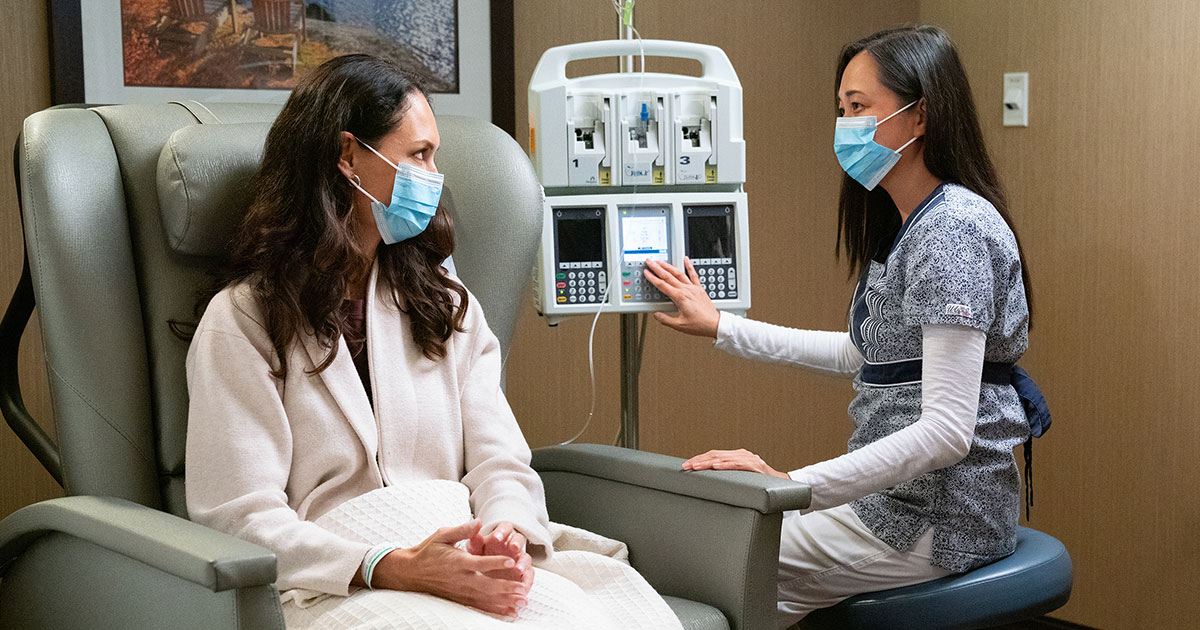
For some cancer patients, the journey may not end when their treatment does, even when their doctor says there’s no evidence of disease. About one in six cancer patients are diagnosed with a second primary cancer years later. A second cancer is not the same as:
- A cancer recurrence, which is a diagnosis of the same cancer in the same or nearby location
- Metastatic cancer, which is a primary cancer that spreads to another part of the body.
Patients who have been diagnosed with specific types of cancer and have other risk factors should be aware of the potential of developing a second cancer and talk to their doctor about treatment options and/or screening protocols.
Treatments and second cancers
Radiation therapy and chemotherapy are two common cancer treatments linked to the potential of developing a second cancer.The risk of developing a solid tumor after radiation therapy depends on several factors, including:
- Age: Patients who are treated with radiation when they’re young are at greater risk when compared with those who undergo radiation as adults. Risk decreases as the age at the time of radiation increases.
- Dose of radiation: The risk goes up as the dose of radiation increases.
- Area treated: Cancers tend to develop in or near the radiated area. Certain areas or organs (including breasts and thyroid) have a higher risk for developing cancers after they’re exposed to radiation.
“An example would be breast cancer in a patient who had been treated years previously for Hodgkin lymphoma with radiation therapy to the chest,” says Pamela Crilley, DO, Chair of the Department of Medical Oncology at Cancer Treatment Centers of America® (CTCA). Lung cancer, she says, is another example of a potential second cancer that may develop from radiation therapy and may occur more than 10 years after initial exposure to radiation treatment.
According to the American Cancer Society (ACS), chemotherapy is known to put patients at greater risk than radiation therapy for developing blood cancers. Blood cancers linked to chemotherapy often include myelodysplastic syndrome (MDS), acute myelogenous leukemia (AML) and acute lymphocytic leukemia (ALL), according to the ACS.
Being aware of the risk for second cancers is especially important for pediatric patients. Children exposed to radiation or chemotherapy have more years to live, giving them more opportunity to develop another cancer.
Reducing your risk
Though the risk of a second cancer is a serious consideration when weighing your treatment options, it’s important to know how advances in cancer treatment may allow doctors to limit this threat.
“Advances in radiation technology have made it possible to target radiation beams to the size, shape and location of the tumor, reducing exposure to healthy tissues and organs,” says Sean Cavanaugh, MD, Chair of the Department of Radiation Oncology at CTCA®. These advances include three-dimensional conformal radiation therapy, intensity-modulated radiation therapy, stereotactic radiotherapy and brachytherapy.
“The way radiation therapy is administered has also changed,” Dr. Cavanaugh says. “For example, traditional external beam radiation therapy is administered daily over several weeks, but stereotactic radiotherapy may be administered in a fewer number of treatments, or just one. The goal is a lower risk of long-term complications, including second cancers.”
Advances in research have also reduced the long-term risks related to chemotherapy treatment. “Selection of chemotherapy agents to eliminate or reduce exposure to alkylating agents [shown to increase the risk of secondary cancers] decreases the risk of long-term second malignancies, such as certain types of leukemia, lymphoma or blood disorders,” Dr. Crilley says.
Patients can play a role in making informed decisions about their treatment and the long-term risk of developing a second cancer, particularly by encouraging patients to ask questions and become well informed. “In-depth discussions with your oncology providers, including your radiation and medical oncologists, will help you understand potential risks, short- or long-term,” Dr. Crilley says. “Your age at the time of the initial treatment of the primary cancer may influence which treatment would be least likely to cause long-term adverse effects.”
Screening and prevention
Effective screening is available for patients at risk for a second cancer. “For example,” Dr Crilley explains, “in women at risk for breast cancer after treatment with radiation for Hodgkin lymphoma, a yearly breast MRI may detect an early second cancer.” Similarly, she says, patients at risk for lung cancer after radiation may consider being screened with a CT scan.
You can also make lifestyle changes that may help reduce your risk of developing a second cancer. These changes include:
- Not smoking
- Reducing or avoiding alcohol
- Getting regular exercise and staying physically active, if you’re able
- Eating a healthy diet
Remain vigilant
Awareness and follow-up are important measures for reducing your cancer risk. Knowing some common symptoms of cancer may help you detect a second cancer early, which may improve outcomes.
Some symptoms of a second cancer may include:
- Changes in bowel or bladder habits
- A sore that does not heal or go away
- Unusual bleeding or discharge
- Thickening tissue or lump in the breast or other parts of your body
- Indigestion or difficulty swallowing
- Noticeable change in a wart or mole
- Nagging cough or hoarseness
- Fatigue or tiredness
- Bone pain
- Changes in vision
- Constant or severe headaches
Having these symptoms doesn't mean you have a second cancer. However, you should talk with your health care provider if you notice these or other symptoms. Make sure your doctor knows as much as possible about your first cancer, its treatment, your general health and your family’s health history.

